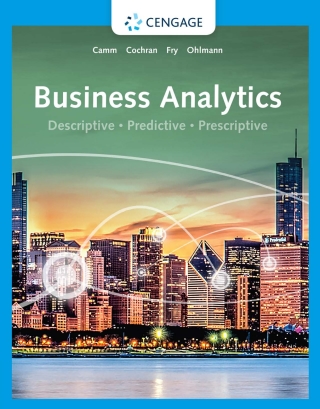Buy Business Analytics, 4th Edition PDF ebook by author Jeffrey D. Camm; James J. Cochran; Michael J. Fry – published by Cengage Learning in 2021 and save up to 80% compared to the print version of this textbook. With PDF version of this textbook, not only save you money, you can also highlight, add text, underline add post-it notes, bookmarks to pages, instantly search for the major terms or chapter titles, etc.
You can search our site for other versions of the Business Analytics, 4th Edition PDF ebook. You can also search for others PDF ebooks from publisher Cengage Learning, as well as from your favorite authors. We have thousands of online textbooks and course materials (mostly in PDF) that you can download immediately after purchase.
Note: e-textBooks do not come with access codes, CDs/DVDs, workbooks, and other supplemental items.
eBook Details:
Full title: Business Analytics, 4th Edition
Edition: 4th
Copyright year: 2021
Publisher: Cengage Learning
Author: Jeffrey D. Camm; James J. Cochran; Michael J. Fry
ISBN: 9780357131916, 9780357131909, 979-8214338705
Format: PDF
Description of Business Analytics, 4th Edition:
Develop the analytical skills that are in high demand in businesses today with Camm/Cochran/Fry/Ohlmann’s best-selling BUSINESS ANALYTICS, 4E. You master the full range of analytics as you strengthen your descriptive, predictive and prescriptive analytic skills. Real examples and memorable visuals illustrate data and results for each topic. Step-by-step instructions guide you through using Microsoft Excel, Tableau, R and JMP Pro software to perform more advanced analytics concepts. Practical, relevant problems at all levels of difficulty help you further apply what you’ve learned. With this edition you become proficient in topics beyond the traditional quantitative concepts, such as data visualization and data mining, which are increasingly important in today’s analytical problem-solving. Trust BUSINESS ANALYTICS, 4E to strengthen your understanding of today’s analytic concepts.Important Notice: Media content referenced within the product description or the product text may not be available in the ebook version.
Table of Contents of Business Analytics, 4th Edition PDF ebook:
Brief ContentsContentsPrefaceChapter 1: Introduction1.1 Decision Making1.2 Business Analytics Defined1.3 A Categorization of Analytical Methods and Models1.4 Big Data1.5 Business Analytics in Practice1.6 Legal and Ethical Issues in the Use of Data and AnalyticsSummaryGlossaryChapter 2: Descriptive Statistics2.1 Overview of Using Data: Definitions and Goals2.2 Types of Data2.3 Modifying Data in Excel2.4 Creating Distributions from Data2.5 Measures of Location2.6 Measures of Variability2.7 Analyzing Distributions2.8 Measures of Association Between Two Variables2.9 Data CleansingSummaryGlossaryProblemsCase Problem 1: Heavenly Chocolates Web Site TransactionsCase Problem 2: African Elephant PopulationsChapter 3: Data Visualization3.1: Overview of Data Visualization3.2: Tables3.3: Charts3.4: Advanced Data Visualization3.5: Data DashboardsSummaryGlossaryProblemsCase Problem 1: Pelican storesCase Problem 2: Movie Theater ReleasesAppendix: Data Visualization in TableauChapter 4: P robability: An Introduction to Modeling Uncertainty4.1 Events and Probabilities4.2 Some Basic Relationships of Probability4.3 Conditional Probability4.4 Random Variables4.5 Discrete Probability Distributions4.6 Continuous Probability DistributionsSummaryGlossaryProblemsCase Problem 1: Hamilton County JudgesCase Problem 2: McNeil’s Auto MallCase Problem 3: Gebhardt ElectronicsChapter 5: Descriptive Data Mining5.1 Cluster Analysis5.2 Association Rules5.3 Text MiningSummaryGlossaryProblemsCase Problem 1: Big Ten ExpansionCase Problem 2: Know Thy CustomerChapter 6: Statistical Inference6.1 Selecting a Sample6.2 Point Estimation6.3 Sampling Distributions6.4 Interval Estimation6.5 Hypothesis Tests6.6 Big Data, Statistical Inference, and Practical SignificanceSummaryGlossaryProblemsCase Problem 1: Young Professional MagazineCase Problem 2: Quality Associates, Inc.Chapter 7: Linear Regression7.1 Simple Linear Regression Model7.2 Least Squares Method7.3 Assessing the Fit of the Simple Linear Regression Model7.4 The Multiple Regression Model7.5 Inference and Regression7.6 Categorical Independent Variables7.7 Modeling Nonlinear Relationships7.8 Model Fitting7.9 Big Data and Regression7.10 Prediction with RegressionSummaryGlossaryProblemsCase Problem 1: Alumni GivingCase Problem 2: Consumer Research, Inc.Case Problem 3: Predicting Winnings for NASCAR DriversChapter 8: Time Series Analysis and Forecasting8.1 Time Series Patterns8.2 Forecast Accuracy8.3 Moving Averages and Exponential Smoothing8.4 Using Regression Analysis for Forecasting8.5 Determining the Best Forecasting Model to UseSummaryGlossaryProblemsCase Problem 1: Forecasting Food and Beverage SalesCase Problem 2: Forecasting Lost SalesAppendix: Using the Excel Forecast SheetChapter 9: Predictive Data Mining9.1 Data Sampling, Preparation, and Partitioning9.2 Performance Measures9.3 Logistic Regression9.4 k-Nearest Neighbors9.5 Classification and Regression TreesSummaryGlossaryProblemsCase Problem: Grey Code CorporationChapter 10: Spreadsheet Models10.1 Building Good Spreadsheet Models10.2 What-If Analysis10.3 Some Useful Excel Functions for Modeling10.4 Auditing Spreadsheet Models10.5 Predictive and Prescriptive Spreadsheet ModelsSummaryGlossaryProblemsCase Problem: Retirement PlanChapter 11: Monte Carlo Simulation11.1 Risk Analysis for Sanotronics LLC11.2 Inventory Policy Analysis for Promus Corp11.3 Simulation Modeling for Land Shark Inc.11.4 Simulation with Dependent Random Variables11.5 Simulation ConsiderationsSummaryGlossaryProblemsCase Problem: Four CornersAppendix: Common Probability Distributions for SimulationChapter 12: Linear Optimization Models12.1 A Simple Maximization Problem12.2 Solving the Par, Inc. Problem12.3 A Simple Minimization Problem12.4 Special Cases of Linear Program Outcomes12.5 Sensitivity Analysis12.6 General Linear Programming Notation and More Examples12.7 Generating an Alternative Optimal Solution for a Linear ProgramSummaryGlossaryProblemsCase Problem: Investment StrategyChapter 13: Integer Linear Optimization Models13.1 Types of Integer Linear Optimization Models13.2 Eastborne Realty, an Example of Integer Optimization13.3 Solving Integer Optimization Problems with Excel Solver13.4 Applications Involving Binary Variables13.5 Modeling Flexibility Provided by Binary Variables13.6 Generating Alternatives in Binary OptimizationSummaryGlossaryProblemsCase Problem: Applecore Children’s ClothingChapter 14: Nonlinear Optimization Models14.1 A Production Application: Par, Inc. Revisited 14.2 Local and Global Optima 14.3 A Location Problem 14.4 Markowitz Portfolio Model14.5 Adoption of a New Product: The Bass Forecasting ModelSummaryGlossaryProblemsCase Problem: Portfolio Optimization with Transaction CostsChapter 15: Decision Analysis15.1 Problem Formulation15.2 Decision Analysis Without Probabilities 15.3 Decision Analysis with Probabilities15.4 Decision Analysis with Sample Information15.5 Computing Branch Probabilities with Bayes’ Theorem15.6 Utility TheorySummaryGlossaryProblemsCase Problem: Property Purchase Strategy Multi-Chapter Case ProblemsAppendix A: Basics of ExcelAppendix B Database Basics with Microsoft AccessReferencesIndex






